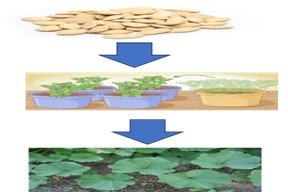Examination of the diversity in pumpkin (Cucurbita maxima L.) growth accessions in south-eastern Nigeria
Abstract
The aim of the study was to compare the growth rates of various pumpkin (Cucurbita maxima L.) accessions. Pumpkins from Aku I, Aku II, Awka, Ifite-Ogwari Nsukka I, and Nsukka II were the various accessions. A field study was conducted at the Ifite-Ogwari Campus of Nnamdi Azikiwe University in Anambra State. The experiment was laid out using a completely randomized design (CRD) with three replications. As experimental sample units, two (2) of the middle-most plants in each polybag were cut off and tagged. Analysis of Variance (ANOVA) was used to analyze data on vegetative growth factors at a 5% probability level and the treatment means were divided using the least significant difference (LSD 0.05). The result of the experiment revealed that all of the pumpkin accessions performed similarly in terms of the amount of time it took for them to emerge after sowing, their percentage of emergence, and their overall vegetative growth. None of the accessions were statistically different with respect to their emergence and growth parameters. However, the growth parameter evaluations were dominated, on average, by pumpkin accession from Nsukka (I and II) pumpkins. In addition, the Aku II pumpkin had the shortest days-to-emergence (3.33 days) and the greatest mean percentage of emergence (100%). Conversely, Aku I pumpkin consistently performed the lowest when it came to the factors that were looked at. For a comprehensive characterization of C. maxima, additional research at the molecular and genomic levels is advised including a greater number of accessions.
Keywords:
Cucurbita maxima, Pumpkin accessions, Vegetative growthDownloads
References
Adeduntan, S. A. (2015). Contribution of some ornamental plants to the socio-economic development of urban household in Akure metropolis. African Journal of Agricultural Research, 10(4), 264–268. https://doi.org/10.5897/ajar2013.7945
Ahmed, G., & A. Khan, A. (2019). Pumpkin: Horticultural Importance and Its Roles in Various Forms; a Review. International Journal of Horticulture and Agriculture, 4(1), 1–6. https://doi.org/10.15226/2572-3154/4/1/00124
Amin, M. Z., Islam, T., Uddin, M. R., Uddin, M. J., Rahman, M. M., & Satter, M. A. (2019). Comparative study on nutrient contents in the different parts of indigenous and hybrid varieties of pumpkin (Cucurbita maxima Linn.). Heliyon, 5(9), e02462. https://doi.org/10.1016/j.heliyon.2019.e02462
Ansar, M., Sher, A., Zaheer, A., Mehmood, A., Hussain, M., Irfan, M., & Majeed, M. (2014). Comparison of hybrid verses composite brassica varieties for forage and seed yield under rainfed conditions of pothwar. Life Science Journal, 11(10 SPEC. ISSUE), 149–154.
Aruah, C. B., Uguru, M. I., & Oyiga, B. C. (2010). Variations among some Nigerian Cucurbita landraces. African Journal of Plant Science, 4(October), 374–386.
Castellanos-Morales, G., Ruiz-Mondragón, K. Y., Hernández-Rosales, H. S., Sánchez-De La Vega, G., Gámez, N., Aguirre-Planter, E., Montes-Hernández, S., Lira-Saade, R., & Eguiarte, L. E. (2019). Tracing back the origin of pumpkins (Cucurbita pepo ssp. Pepo L.) in Mexico. Proceedings of the Royal Society B: Biological Sciences, 286(1908). https://doi.org/10.1098/rspb.2019.1440
Chukwudi, U. P., & Agbo, C. U. (2017). Characterization and preliminary evaluation of local germplasm of Telfairia occidentalis Hook F. accessions in Enugu, Nigeria. Agro-Science, 15(2), 15. https://doi.org/10.4314/as.v15i2.3
Darshani, W. M. R., Nashath, M. N. F., Niran, H. M. L., and Mubarak, & A. N. M. (2021). Evaluation of Morphological and Yield Characteristics of Selected Local Pumpkin Accessions in Sri Lanka. 2017(Icst), 978–624.
Fapohunda, S. O., Adewumi, A. A., & Jegede, D. O. (2018). Cucurbitaceae - the family that nourishes and heals. MicroMedicine, 6(2), 85–93.
Hosen, M., Rafii, M. Y., Mazlan, N., Jusoh, M., Oladosu, Y., Chowdhury, M. F. N., Muhammad, I., & Khan, M. M. H. (2021). Review pumpkin (Cucurbita spp.): A crop to mitigate food and nutritional challenges. Horticulturae, 7(10). https://doi.org/10.3390/horticulturae7100352
Malley, B. O. (2008). Cucurbitaceae Scientific Classification.
Matthews, S., & Khajeh Hosseini, M. (2006). Mean germination time as an indicator of emergence performance in soil of seed lots of maize (Zea mays). Seed Science and Technology, 34(2), 339–347. https://doi.org/10.15258/sst.2006.34.2.09
Mavi, K., Demir, I., & Matthews, S. (2010). Mean germination time estimates the relative emergence of seed lots of three cucurbit crops under stress conditions. Seed Science and Technology, 38(1), 14–25. https://doi.org/10.15258/sst.2010.38.1.02
Ogbonna, O. (2013). Floral habits and seed production characteristics in Egusi melon (Colocynthis citrullus L.). Journal of Plant Breeding and Crop Science, 4(6), 137–140. https://doi.org/10.5897/jpbcs2013.0381
Oluoch, M. O. (2012). Production Practices of Pumpkins for Improved Productivity. Scripta Horticulturae, 15(January 2012), 181–189.
Rahman, A. H. M. M., Anisuzzaman, M., Ahmed, F., Islam, A. K. M. R., & Naderuzzaman, A. T. M. (2008). Study of nutritive value and medicinal uses of cultivated cucurbits. Journal of Applied Sciences Research, 4(5), 555–558.
Sandra, D., Argueta, E., Wacher, N. H., Silva, M., Valdez, L., Cruz, M., Gómez-Díaz, R. A., Casas-saavedra, L. P., De Orientación, R., Salud México, S. de, Virtual, D., Social, I. M. del S., Mediavilla, J., Fernández, M., Nocito, A., Moreno, A., Barrera, F., Simarro, F., Jiménez, S., & Faizi, M. F. (2016). No socio-economic factors influencing smallholder pumpkin production, consumption and marketing in eastern and central Kenya region. Revista CENIC. Ciencias Biológicas, 152(3), 28.https://doi.org/10.15446/revfacmed.v66n3.60060.%0Ahttp://www.cenetec.

Published
How to Cite
Issue
Section
Copyright (c) 2024 Agriculture and Environmental Science Academy

This work is licensed under a Creative Commons Attribution-NonCommercial 4.0 International License.

